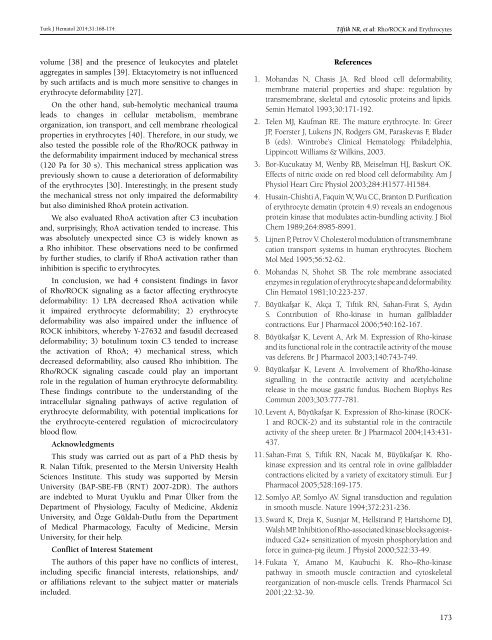Turkish Journal of Hematology Volume: 31 - Issue: 2
Create successful ePaper yourself
Turn your PDF publications into a flip-book with our unique Google optimized e-Paper software.
Turk J Hematol 2014;<strong>31</strong>:168-174<br />
Tiftik NR, et al: Rho/ROCK and Erythrocytes<br />
volume [38] and the presence <strong>of</strong> leukocytes and platelet<br />
aggregates in samples [39]. Ektacytometry is not influenced<br />
by such artifacts and is much more sensitive to changes in<br />
erythrocyte deformability [27].<br />
On the other hand, sub-hemolytic mechanical trauma<br />
leads to changes in cellular metabolism, membrane<br />
organization, ion transport, and cell membrane rheological<br />
properties in erythrocytes [40]. Therefore, in our study, we<br />
also tested the possible role <strong>of</strong> the Rho/ROCK pathway in<br />
the deformability impairment induced by mechanical stress<br />
(120 Pa for 30 s). This mechanical stress application was<br />
previously shown to cause a deterioration <strong>of</strong> deformability<br />
<strong>of</strong> the erythrocytes [30]. Interestingly, in the present study<br />
the mechanical stress not only impaired the deformability<br />
but also diminished RhoA protein activation.<br />
We also evaluated RhoA activation after C3 incubation<br />
and, surprisingly, RhoA activation tended to increase. This<br />
was absolutely unexpected since C3 is widely known as<br />
a Rho inhibitor. These observations need to be confirmed<br />
by further studies, to clarify if RhoA activation rather than<br />
inhibition is specific to erythrocytes.<br />
In conclusion, we had 4 consistent findings in favor<br />
<strong>of</strong> Rho/ROCK signaling as a factor affecting erythrocyte<br />
deformability: 1) LPA decreased RhoA activation while<br />
it impaired erythrocyte deformability; 2) erythrocyte<br />
deformability was also impaired under the influence <strong>of</strong><br />
ROCK inhibitors, whereby Y-27632 and fasudil decreased<br />
deformability; 3) botulinum toxin C3 tended to increase<br />
the activation <strong>of</strong> RhoA; 4) mechanical stress, which<br />
decreased deformability, also caused Rho inhibition. The<br />
Rho/ROCK signaling cascade could play an important<br />
role in the regulation <strong>of</strong> human erythrocyte deformability.<br />
These findings contribute to the understanding <strong>of</strong> the<br />
intracellular signaling pathways <strong>of</strong> active regulation <strong>of</strong><br />
erythrocyte deformability, with potential implications for<br />
the erythrocyte-centered regulation <strong>of</strong> microcirculatory<br />
blood flow.<br />
Acknowledgments<br />
This study was carried out as part <strong>of</strong> a PhD thesis by<br />
R. Nalan Tiftik, presented to the Mersin University Health<br />
Sciences Institute. This study was supported by Mersin<br />
University (BAP-SBE-FB (RNT) 2007-2DR). The authors<br />
are indebted to Murat Uyuklu and Pınar Ülker from the<br />
Department <strong>of</strong> Physiology, Faculty <strong>of</strong> Medicine, Akdeniz<br />
University, and Özge Güldalı-Dutlu from the Department<br />
<strong>of</strong> Medical Pharmacology, Faculty <strong>of</strong> Medicine, Mersin<br />
University, for their help.<br />
Conflict <strong>of</strong> Interest Statement<br />
The authors <strong>of</strong> this paper have no conflicts <strong>of</strong> interest,<br />
including specific financial interests, relationships, and/<br />
or affiliations relevant to the subject matter or materials<br />
included.<br />
References<br />
1. Mohandas N, Chasis JA. Red blood cell deformability,<br />
membrane material properties and shape: regulation by<br />
transmembrane, skeletal and cytosolic proteins and lipids.<br />
Semin Hematol 1993;30:171-192.<br />
2. Telen MJ, Kaufman RE. The mature erythrocyte. In: Greer<br />
JP, Foerster J, Lukens JN, Rodgers GM, Paraskevas F, Blader<br />
B (eds). Wintrobe’s Clinical <strong>Hematology</strong>. Philadelphia,<br />
Lippincott Williams & Wilkins, 2003.<br />
3. Bor-Kucukatay M, Wenby RB, Meiselman HJ, Baskurt OK.<br />
Effects <strong>of</strong> nitric oxide on red blood cell deformability. Am J<br />
Physiol Heart Circ Physiol 2003;284:H1577-H1584.<br />
4. Husain-Chishti A, Faquin W, Wu CC, Branton D. Purification<br />
<strong>of</strong> erythrocyte dematin (protein 4.9) reveals an endogenous<br />
protein kinase that modulates actin-bundling activity. J Biol<br />
Chem 1989;264:8985-8991.<br />
5. Lijnen P, Petrov V. Cholesterol modulation <strong>of</strong> transmembrane<br />
cation transport systems in human erythrocytes. Biochem<br />
Mol Med 1995;56:52-62.<br />
6. Mohandas N, Shohet SB. The role membrane associated<br />
enzymes in regulation <strong>of</strong> erythrocyte shape and deformability.<br />
Clin Hematol 1981;10:223-237.<br />
7. Büyükafşar K, Akça T, Tiftik RN, Sahan-Fırat S, Aydın<br />
S. Contribution <strong>of</strong> Rho-kinase in human gallbladder<br />
contractions. Eur J Pharmacol 2006;540:162-167.<br />
8. Büyükafşar K, Levent A, Ark M. Expression <strong>of</strong> Rho-kinase<br />
and its functional role in the contractile activity <strong>of</strong> the mouse<br />
vas deferens. Br J Pharmacol 2003;140:743-749.<br />
9. Büyükafşar K, Levent A. Involvement <strong>of</strong> Rho/Rho-kinase<br />
signalling in the contractile activity and acetylcholine<br />
release in the mouse gastric fundus. Biochem Biophys Res<br />
Commun 2003;303:777-781.<br />
10. Levent A, Büyükafşar K. Expression <strong>of</strong> Rho-kinase (ROCK-<br />
1 and ROCK-2) and its substantial role in the contractile<br />
activity <strong>of</strong> the sheep ureter. Br J Pharmacol 2004;143:4<strong>31</strong>-<br />
437.<br />
11. Sahan-Fırat S, Tiftik RN, Nacak M, Büyükafşar K. Rhokinase<br />
expression and its central role in ovine gallbladder<br />
contractions elicited by a variety <strong>of</strong> excitatory stimuli. Eur J<br />
Pharmacol 2005;528:169-175.<br />
12. Somlyo AP, Somlyo AV. Signal transduction and regulation<br />
in smooth muscle. Nature 1994;372:2<strong>31</strong>-236.<br />
13. Sward K, Dreja K, Susnjar M, Hellstrand P, Hartshorne DJ,<br />
Walsh MP. Inhibition <strong>of</strong> Rho-associated kinase blocks agonistinduced<br />
Ca2+ sensitization <strong>of</strong> myosin phosphorylation and<br />
force in guinea-pig ileum. J Physiol 2000;522:33-49.<br />
14. Fukata Y, Amano M, Kaubuchi K. Rho–Rho-kinase<br />
pathway in smooth muscle contraction and cytoskeletal<br />
reorganization <strong>of</strong> non-muscle cells. Trends Pharmacol Sci<br />
2001;22:32-39.<br />
173

















